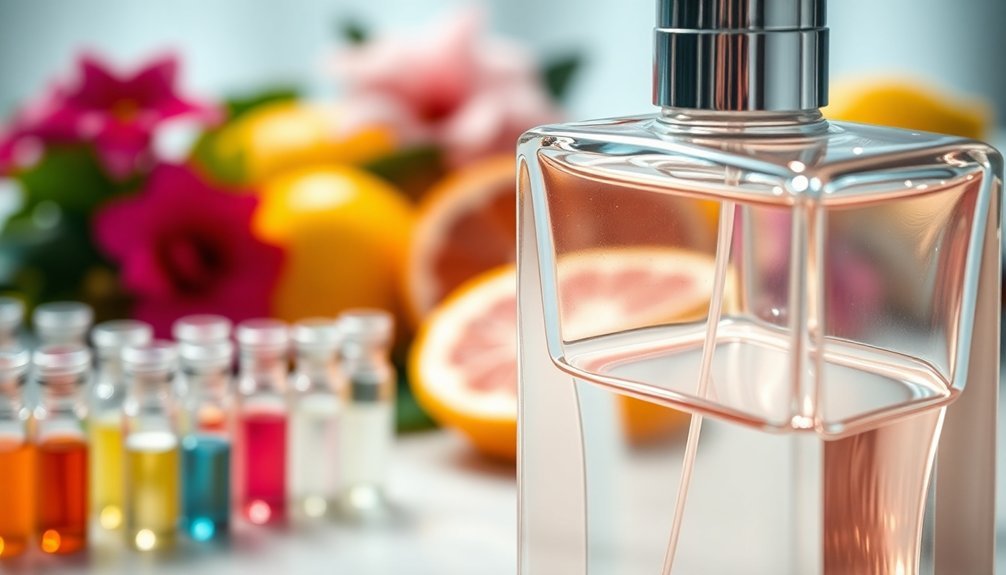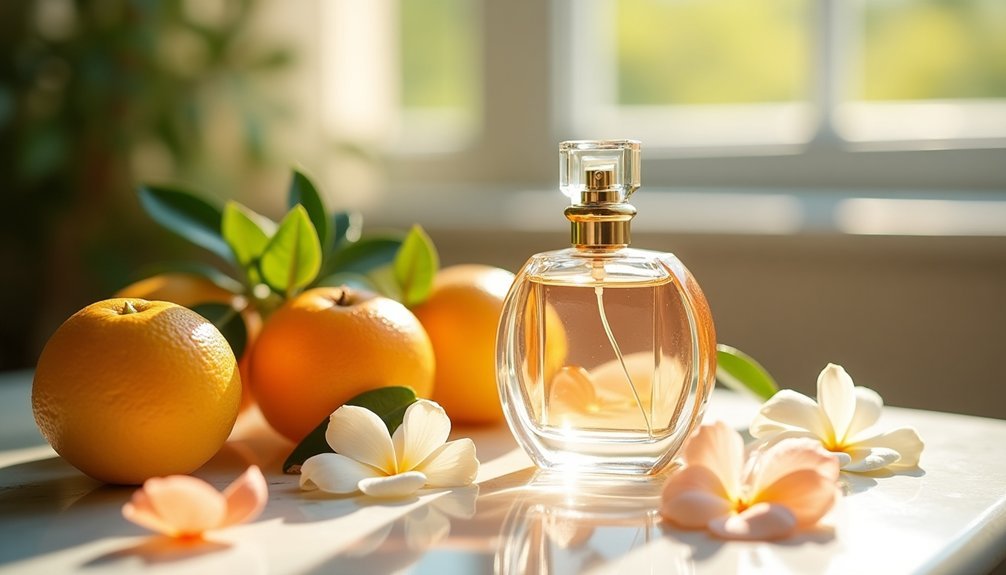Measuring top notes helps you understand how your fragrance will perform during its essential first 15 minutes of wear. You'll gain insight into the initial scent burst and its evolution through precise evaluation of intensity and dissipation rates. With proper measurement tools like scent strips and timed assessments, you can predict fragrance behavior and make informed choices. Expert techniques and systematic testing will transform your approach to selecting the perfect scent.
The Science Behind Top Note Intensity

While many perfume enthusiasts focus on a fragrance's lasting power, the science of top notes reveals the essential first chapter of any scent story.
When you spray a perfume, you'll immediately encounter these volatile components, which create your initial olfactory experience within the first 5-15 minutes.
The intensity of these fleeting notes depends directly on their fragrance concentration in the formula.
You'll typically find bright, fresh elements like citrus and herbs leading the composition.
These components aren't just randomly selected – they're carefully measured to achieve the perfect opening impact while setting up a smooth shift to the middle notes.
Understanding how these top notes perform is significant because they'll shape your first impression and influence how you experience the fragrance's complete evolution.
Essential Tools for Measuring Fragrance Strength
You'll find essential precision tools like refractometers and hydrometers at the core of professional fragrance measurement, enabling accurate assessment of perfume concentration levels.
Digital analysis through GC-MS systems takes measurement further by precisely identifying individual fragrance components and their proportions within your scent blend.
Manual testing methods, including trained sensory panels, complement these tools by providing real-world feedback on fragrance intensity and performance.
Precision Scent Testing Equipment
Professional perfumers rely on sophisticated testing equipment to measure and validate fragrance intensity with scientific precision.
You'll find gas chromatography and mass spectrometry at the heart of precision scent testing equipment, enabling detailed analysis of fragrance oils and their concentrations.
To assess the quality of essential oils, you can use refractometers that measure refractive indices, while olfactometers help evaluate specific scent notes and fragrance longevity through controlled delivery methods.
Modern electronic noses complement these tools by detecting volatile compounds with advanced sensor technology.
When you're working to create balanced fragrances, these instruments guarantee consistent quality across different formulations.
Together, these precision tools give you the ability to measure, adjust, and perfect your scent profiles with scientific accuracy.
Digital Fragrance Analysis Tools
Modern digital fragrance analysis tools have revolutionized the measurement of scent intensity through sophisticated algorithms and data-driven insights.
You'll find these tools employ gas chromatography and mass spectrometry to precisely analyze how fragrance notes behave over time, particularly those quick-evaporating top notes that define a perfume's initial impression.
These user-friendly platforms help you visualize and track changes in scent profiles, making it easier to compare different formulations.
You can monitor evaporation rates and intensity levels with unprecedented accuracy, ensuring your fragrances maintain their desired balance throughout wear.
Whether you're a perfumer fine-tuning a composition or a marketer aligning products with consumer preferences, digital fragrance analysis tools provide the quantitative data you need to make informed decisions about scent strength and longevity.
Manual Measurement Methods
Several essential manual tools form the foundation of accurate fragrance strength measurement. You'll need a graduated pipette and scale to precisely measure liquid and solid fragrance components. These measurement methods guarantee you can create consistent formulations while analyzing top notes.
| Tool | Primary Function |
|---|---|
| Refractometer | Measures volatile concentration |
| Pipette | Liquid measurement |
| Scale | Solid ingredient weighing |
When evaluating fragrance intensity, you'll want to use olfactory strips for blind testing, allowing you to compare top notes against other fragrance components objectively. Remember to maintain consistent temperature and humidity in your testing environment, as these conditions directly affect the evaporation rate of top notes. For more detailed analysis, you can employ gas chromatography to identify and quantify individual fragrance elements in your formulation.
Top Note Evaporation Rates and Their Impact
Have you ever noticed how quickly the initial burst of a fragrance seems to fade?
That's because top notes dissipate within the first 5-15 minutes after you apply your perfume. These volatile elements greatly shape your first impression of the scent, but they won't stick around for long.
Temperature plays an important role in how quickly these notes evaporate. When it's warmer, you'll find that fragrance intensity diminishes faster as evaporation rates increase.
This is why perfumers carefully measure these rates during development – they need to guarantee the progression to middle notes occurs smoothly.
Common top notes like citrus and spicy scents are specifically designed to grab your attention quickly, but they rely on well-balanced middle notes to maintain the scent's appeal once they fade.
Balancing Top Notes With Other Layers

With top notes setting the stage for your fragrance experience, mastering their balance with middle and base notes becomes an art form.
You'll want to guarantee your fragrance composition achieves harmony between all layers, as this creates a seamless shift throughout wear.
When balancing your fragrance layers, consider these essential factors:
- Top notes should enhance, not overpower, the deeper elements of your fragrance, lasting just 5-15 minutes before fading.
- Middle notes need to emerge naturally as the initial burst of top notes dissipates.
- The ratio of top notes to other layers must be precisely measured to maintain the desired intensity.
You'll find that successful fragrances rely on careful measurements and thoughtful combinations of top notes that complement rather than compete with the underlying scent structure.
Common Mistakes in Top Note Measurement
Creating the perfect fragrance blend requires avoiding key measurement pitfalls that can compromise your top notes. When you're evaluating these delicate initial scents, don't rely solely on first impressions, as they only represent 5-15 minutes of the fragrance's life.
You'll want to test on skin rather than blotter strips since your body chemistry greatly affects how top notes develop. Pay attention to ingredient volatility, as some citrus and herbal notes evaporate faster than others, impacting overall fragrance perception.
Environmental factors like temperature and humidity can also alter your measurements – warmer conditions speed up evaporation rates. Another common mistake is misjudging top note concentration in your formulations.
Professional Techniques for Scent Evaluation

Professional scent evaluation builds upon proper measurement techniques by implementing systematic methods for analyzing fragrances.
You'll need to understand how to use olfactory standards and fragrance wheels to accurately identify top notes in any composition.
To conduct a professional fragrance evaluation, follow these key steps:
- Apply the scent to test strips in a controlled environment where temperature and humidity won't interfere with your assessment.
- Allow the top notes to settle for several minutes before beginning your analysis.
- Document the progression of the scent, noting how quickly the top notes dissipate.
When you're working with fragrances professionally, you'll want to perform blind tests to maintain objectivity.
Using reference standards helps calibrate your nose and guarantees consistency in your evaluations, leading to more reliable results.
Creating Your Top Note Testing System
You'll need reliable testing tools to measure fragrance intensity, including scent strips and a timing device to track the evolution of top notes.
To maintain consistency in your evaluations, establish a specific sampling duration—typically 5-15 minutes—and use a numerical rating scale from 1-10 to assess each fragrance's initial strength.
Control your testing environment by sampling no more than three fragrances per session and cleansing your olfactory palette with coffee beans between each test.
Scent Strength Assessment Tools
To build an effective top note testing system, you'll need specific tools and methods that assure consistent evaluation of fragrance intensity.
The right scent strength assessment tools can transform your fragrance testing experience and help you make informed decisions about your perfume choices.
Key tools for measuring top notes include:
- Scent strips and blotters for sampling fragrances in a controlled manner
- A fragrance wheel to categorize and compare different scent families
- A calibrated olfactometer for precise intensity measurements
Remember to maintain consistent testing conditions, including temperature and humidity, to assure accurate results.
Track your observations using a 1-10 rating scale, creating your personal fragrance reference guide. This systematic approach will help you better understand and evaluate the strength of top notes across different fragrances.
Sampling Time Control Methods
Three essential time control methods form the foundation of a reliable top note testing system.
First, you'll need a precise timer to track the critical 5-15 minute window when top notes are most prominent. This helps you understand their dissipation rate and overall fragrance intensity.
Second, maintain a detailed fragrance journal where you'll record your observations during each sampling session. Document the initial burst of scent and how it evolves throughout the testing period.
Finally, implement a systematic sampling schedule with consistent environmental conditions. Use scent strips for initial testing, and don't forget to cover fragrance labels to prevent bias.
This structured approach guarantees you're evaluating each scent objectively and can make reliable comparisons between different fragrances' top notes.
Frequently Asked Questions
What Is the 30 50 20 Rule for Perfume?
You'll want to blend your perfume using 30% top notes for initial impact, 50% middle notes for character, and 20% base notes for longevity. This creates a balanced fragrance that evolves beautifully over time.
What Does Top Note Mean Fragrance?
Top notes are what you'll smell first when you apply your fragrance. They're light, fresh scents that evaporate quickly, usually within 15 minutes, and create your perfume's initial impression.
What Does Intensity Mean in Fragrances?
In fragrances, intensity refers to how strong your scent projects and lasts. You'll notice it's determined by the concentration of fragrance oils and how the scent disperses when you wear it.
What Are the Top Notes of the Fragrance Pyramid?
You'll notice citrus and fresh herbal scents like bergamot, lemon, grapefruit, and peppermint as top notes. They're the first scents you experience, lasting about 5-15 minutes after application.
In Summary
You'll find that measuring top notes is essential for creating balanced, long-lasting fragrances. By understanding evaporation rates and using proper measurement techniques, you're able to craft scents that unfold beautifully over time. Keep practicing your evaluation skills, invest in quality tools, and don't forget to document your findings. With these fundamentals mastered, you'll develop signature fragrances that truly stand out.





Leave a Reply